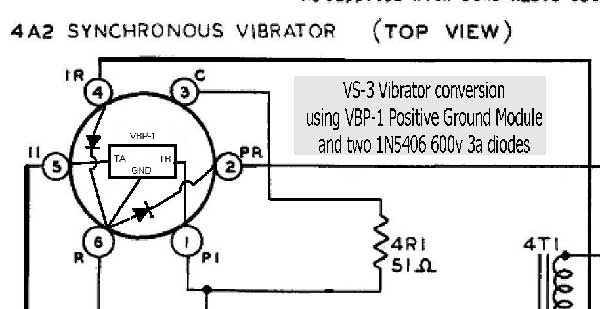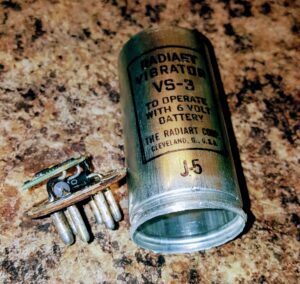VS-3 VIBRATOR CONVERSION
CONVERTING THE RADIART VS-3 SYNCHRONOUS VIBRATOR WITHIN POWER UNIT PE-104-A FOR USE IN THE SCR-284 (BC-654) RADIO (REVISED 09/20/2023)
By Carl Reinemann
With major technical advice and schematic from Craig, N6CAV and KA6BFB Dave.
Mechanical vibrators used in the power supplies of most WWII era radios have to basic states- on its way to failing or, failing. My first attempt at getting my early model Crosley SCR-284 operationally involved opening up the vibrator housing, and ever so carefully, cleaning and burnishing the contacts inside the vibrator. I was successful in this and did get satisfactory results and got my radio set operational.
However, in doing some research, I stumbled across a paper written by Craig, N6CAV with contributions by Tom Murphy W6TOM, regarding the conversion of a DY-88 power supply vibrator for the GRC-9 transceiver to solid state. (Craig N6CAV) This PDF file for the DY-88 (NOTE THIS IS NOT THE ONE FOR THE SCR-284)may be found here, and you may want to review it: http://www.radionerds.com/index.php/File:Wire_VBN-1.pdf
I will not restate what is included in the DY-88 article, as much of it pertains to the VBx-1 Module. Note that the module for the DY-88 vibrator requires the VBN-1 module (Negative Ground) while the VS-3 conversion requires the VBP-1 module (Positive Ground). (VBP-1)
NOTE: The PE-104-A is designed to run off of 12 VDC or 6 VDC via a switch on the top of the PE-104-A. This Design is only for running the unit on 12 VDC Only.
Since I had a good working VS-3 6 Pin vibrator and did not want to damage it (Don’t fix what isn’t broke theory), I was able to obtain a Mallory 6 pin vibrator as my sacrificial test subject and for the base.
NOTE: Take basic safety precautions, you are working with deadly DC voltages. Wear Safety Glasses, and take static precautions when handling the VBP Module.
****My Restoration page of my SCR-284 can be accessed here : SCR-284
I am an authorized dealer of the VBx-1 Module, If you would like to order a module, click here and choose which version you are interested in.
Working Schematic:
Closeup of Schematic from TM-11-310 of PE-104-A

The full schematic can be found on my website listed at the end of the article.
Disassembly:
First, the phenolic base and pins need to be separated from the ‘can’ that the vibrator is mounted to. I used a handheld grinder clamped to my bench, with a sanding disk attached and sanded away the rim from the very edge of the can. Sand carefully, it does not take much effort, once you have JUST exposed the phenolic disk, stop.
Then you can remove the mechanical vibrator from within the can. As you can see, the internal degradation is quite significant. The old material and foam padding basically disintegrated once removed from the can, and as you can see in the photos, all the wire insulation internally was dry rotted and left the wires exposed.
Next steps involve de-soldering the connections from the base. I did this with my soldering gun. Simply holding the tip to a pin for a few seconds and pulling slightly on the wires and they came out easily.

Once the wires were removed, I used a Dremel tool to clean up the pins and prepped the socket for new wiring.
Numbering the Pins:
Turn the phenolic base with the pins so the pins are facing up, with the two large-diameter pins at the bottom, on mine. There was a tab in the phenolic between those two large-diameter pins that came off during disassembly. The pins are numbered 1 to 6, pin 1 is the large diameter pin on the left, and pins are counted clockwise from that pin.

I chose to write with pencil onto the phenolic disk on both sides to make sure I had the pin number correct after I flipped it over.

Attachment of the two diodes was next. I used two 1N5406 600V 3 amp Diodes. Pin 4 to diode to pin 6, and Pin 6 to diode to pin 2. Then using 20AWG wire I bent and aligned them to fit into the mounts of the VBP-1 Module. Note the spaghetti tubing on the wire coming from pin 1 to avoid any future contact with the diode mounted below.

Next the VBP Module is soldered to the base wires, Pin 5 to TA of the VBP-1, Pin 6 to GND of the VBP-1 and Pin 6 to TB of the VBP-1 module.

Close up of mounted diodes and VBP-1 Module.

Testing:
I installed the converted module above into the PE-104-A PS, (without the can), then, bench tested the PE-104-A with power supplied by a regulated PS with +13.8v going to pin 1 and -13.8v going to pin 6 of the octo socket on the front of the PE-104-A.
VOLTAGES:
Here are the voltages obtained before and after conversion.
PE-104-A Voltages from Socket
| VS-3 | VBP-1 | Spec | |
| PIN 1 | +13.8 | +13.8 | 12 VDC |
| PIN 2 | 0 | 0 | 0 VDC |
| PIN 3 | -13.8 | -13.8 | 12 VDC |
| PIN 4 | -1.5 | -1.5 | -1.5 VDC |
| PIN 5 | +115.7 | +121.8 | +84 VDC |
| PIN 6 | -13.8 | -13.8 | -12 VDC |
| PIN 7 | -13.8 | -13.8 | -12 VDC |
| PIN 8 | -70.2 | -81.5 | -51 VDC |
| VS-3 Socket Voltages | |||
| VS-3 | VBP-1 | ||
| PIN 1 | -13.5 | -13.7 | |
| PIN 2 | +117.2 | +121.3 | |
| PIN 3 | -4.3 | -13.7 | |
| PIN 4 | -70.7 | -81.8 | |
| PIN 5 | -13.5 | -13.6 | |
| PIN 6 | 0 | 0 |
Chassis GND to Pin 1 -13.8 VDC
It is important to note that I used 13.8V as my input, rather than a flat 12V. This, coupled with the VBP-1 Modules much higher efficiency explains some of the voltage variations, in which the operating voltages are a little higher. That will put higher plate voltages on the tubes…and the radio will be more “sensitive” (higher amplification). There are higher resistances in the leads/contacts/windings of the VS-3 versus the VBP-1. This means that the original vibrator’s lower operating voltages are due to the voltage dropped across the contacts. The solid-state FETs on the VBP-1 have a very low ‘ON’ resistance, and as a result…the output voltages are a little higher.
Powering the SCR-284 Up
I then inserted and connected the PE-104-A into the BC-654 Radio and turned it on, success! And without the “hum” of the vibrator and more stable power conversion, I found the radio more sensitive to radio stations.
Restoring the Can:
I decided to use an NOS vibrator can to mount the converted assembly into rather than the Malory can, to keep the authentic look to the part. I also labeled the can on the lower edge that it had been converted to solid-state, and the date of conversion. Using a two-part epoxy I remounted the base into the “new” can:
Next Steps:
I have replaced most of the paper capacitors in the radio, next I will be working on replacing the electrolytic capacitors.
Hope this works for you! If you have questions, I will do my best to help you out.
DOCUMENTATION:
PE-104-A Schematic in PDF format, showing new conversion: PE-104-A Conversion Schematic
This entire Article in a PDF format: Converting the Radiart VS-3 to Solid State Electronics
Tech -Retro VBP-1 Technical Documentation VBX-1
SUPPLIERS
VBP-1 Module -I am an authorized dealer of the VBx-1 Module, If you would like to order a module, click here and choose which version you are interested in.
Capacitors, Resistors – Just Radios http://justradios.com/
Diodes, wire – https://www.radioshack.com/ (yup, still open online)
WORKS CITED
Craig Vonilten, T. M. (n.d.). File:Wire VBN-1.pdf. Retrieved from Radionerds.com: http://www.radionerds.com/index.php/File:Wire_VBN-1.pdf
VBP-1. (n.d.). Aurora Design. Retrieved from http://www.tech-retro.com







